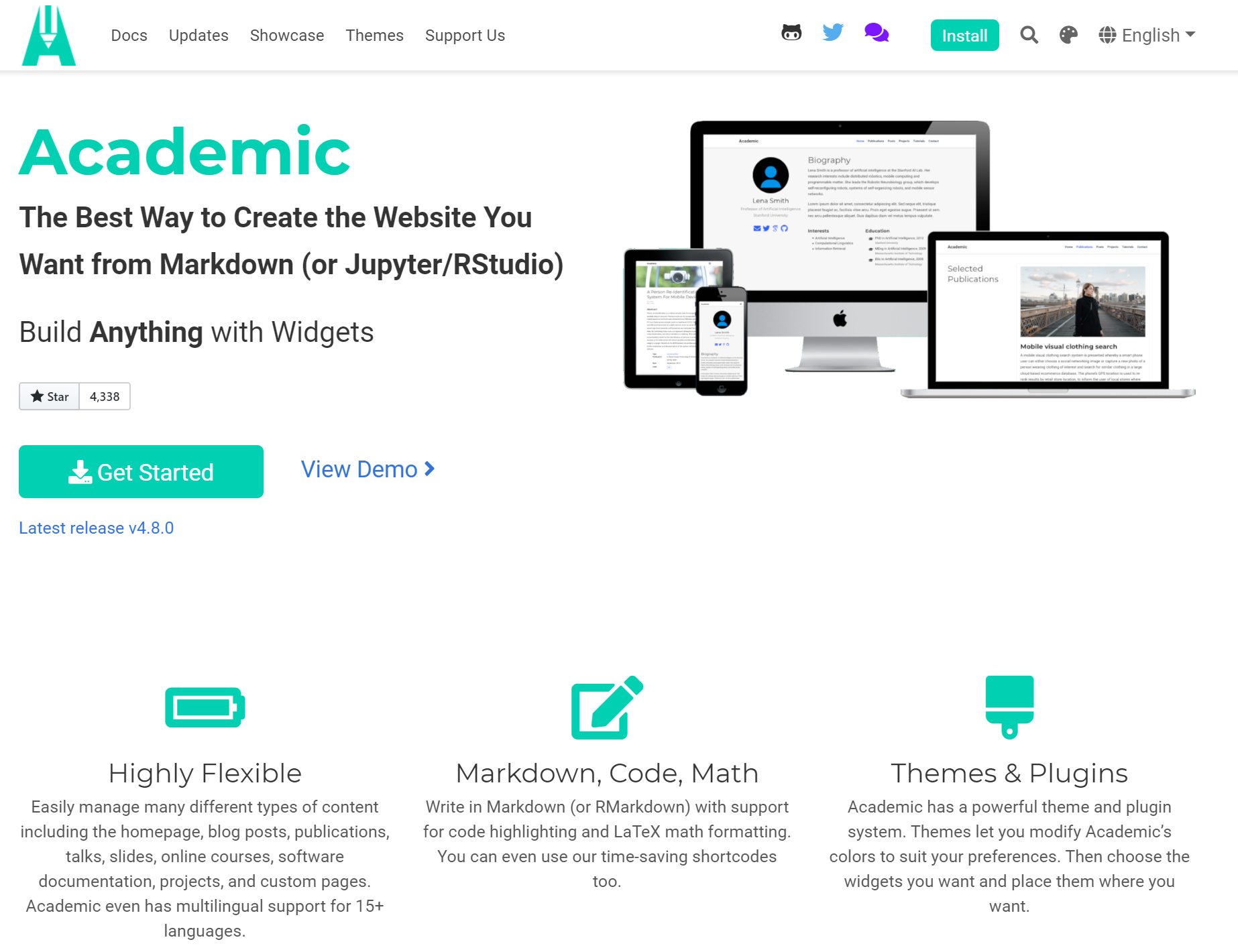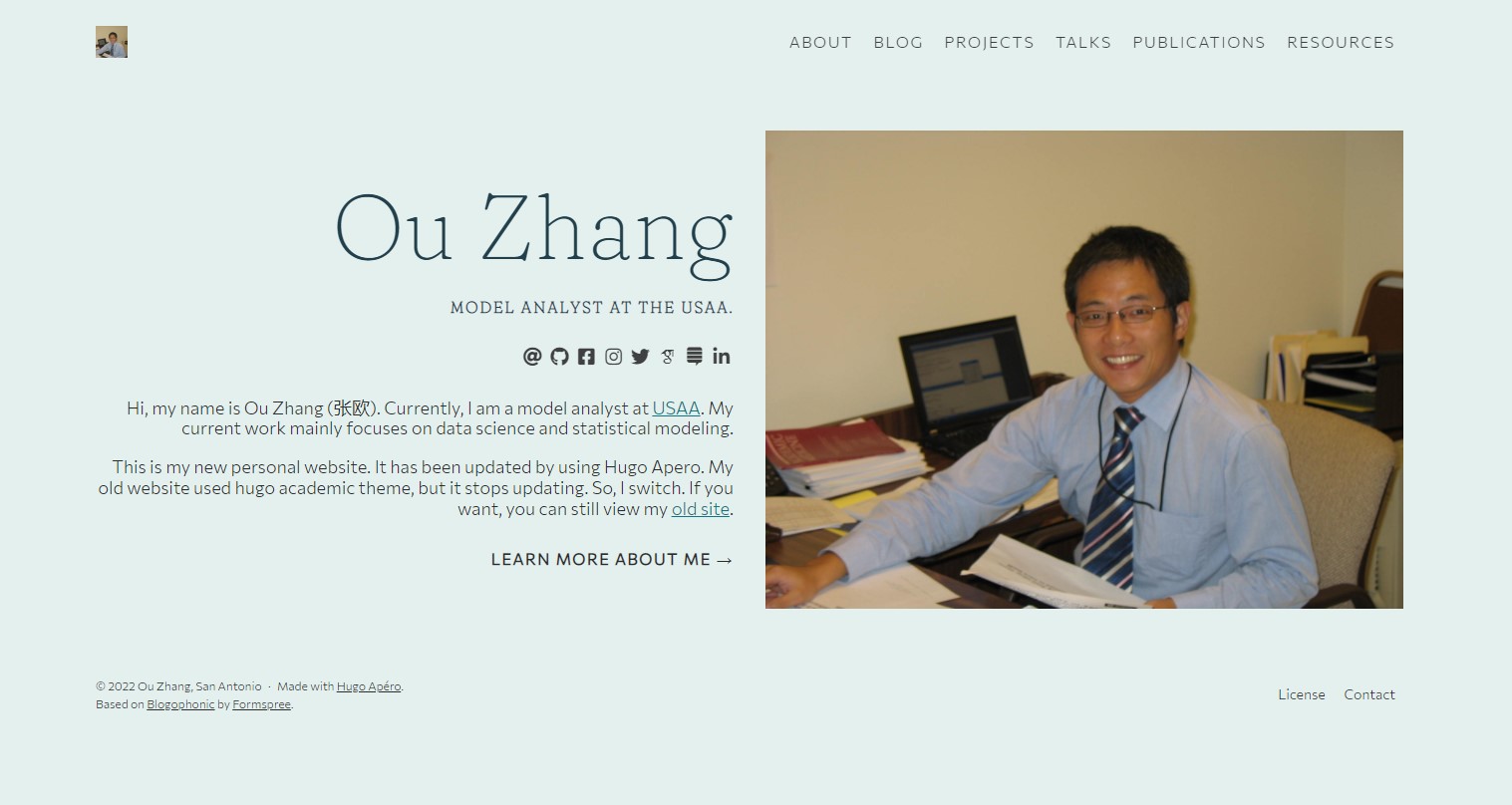The Evolution Story of My Website
A blog on how my website has evolved since I adapted blogdown.
By Ou Zhang in Blogdown Rmarkdown
March 1, 2022
Hi, I'm the here-bot cat!
Use me to find your way in your website.
- Here I am:
- content/blog/2022-03-01-the-evolution-story-of-my-website/index.markdown
- Here is my R Markdown source file:
- blog/2022-03-01-the-evolution-story-of-my-website/index.Rmarkdown
You'll want to edit this file, then re-knit to see the changes take effect in your site preview.
To remove me, delete this line inside that file: {{< here >}}
- My content section is:
- blog
- My layout is:
- single-sidebar
- Images in this page bundle:
- /blog/blogdown/featured.jpg
- /blog/blogdown/img/current_webpage.jpg
- /blog/blogdown/img/first_webpage.jpg
- /blog/blogdown/img/hugo-academic.jpg
- /blog/blogdown/img/second_webpage.jpg
My website story
When you are reading this blog, Congratulations👏, you’ve already found my website. Technically, you don’t need to keep reading this blog 😄 and this could save you 7 minutes. This blog records my website development story.
Before we start, let me give you some back-scene stories of my building-website history. Since I was a college student, I’ve always wanted to build up my personal website so that I have a place to chat and record my life.
My first website was built until my graduate school era (2011). My first website was simple and straightforward. It was completely built by html through Dreamweaver, with some css style helps from my friend. The website content is static and it has no dynamic data exchanging features at all. The site is purely a showcase to my studies and works. By the time when I built the website, I wish the job recruiters and my future employers could get to know me more through my website. Luckily, this simple html website, to some extent, helped me land my first job in US.
Back in old days, building a website required a huge amount of time to carve details, like fonts, colors, and styles (e.g., css) set-up. Developers also need to tune in and monitor tons of html parameters. Building a website is an exhausting and time-consuming activity. What’s more, website maintenance makes the website-building even harder. Back then, I didn’t even know where I could find a platform to host my website. Therefore, my first site was built and hosted on the university’s server. Unfortunately, soon after my graduation, it is expired and could never be retrieved.
Many years later, I happened to learn rmarkdown and its R-package from the 2019 RStudio conference. Later that year, I found a new R package-blogdown developed by the same developer who developed rmarkdown. Being a long-time R-user, I surprisingly see it provides a tool for R-Users to build a website in R. Amazing!!
Meanwhile, the connection between git and RStudio makes website building much easier and smoother. No Dreamweaver and FTP are needed. Just simply using
RStudio and
github, anyone can build his own site.
When I first touched this r-package, I was excited. An immediate action was taken by myself. After many days and nights, hard works and thousand times of debugging, I finally built up my first blogdown website.As always, the first version of my website was not a beauty. But it’s a good start, and it has all the functions I need.
It was built through blogdown with easy theme-hugo-lithium. The
site adapted a simple theme directly from Yihui Xie’s Blogdown book.

Figure 1: 1st website look
As you can see from the picture, it contains a very simple layout with some minimum website functions. it’s a good start but a professional website shouldn’t look like that. There must be better themes to suit my needs-more professional and fancier. I must find a better theme for my website. I speak to mysellf. So, after some researches and googlings, I found this theme-Hugo-academic (see below).

Figure 2: Hugo Academic Template
The template looks much nicer and more professional, with many intriguing features. Without any hesitation, I decided to switch my website to this theme. However, complicated feature means obstacles. Throughout the theme-switch process, I encountered hundreds of issues and bugs which lead to countless upsets and frustrations.
To make it work, I had to rely on online searching and asking questions on
Stack Overflow to solve/break every brick wall I bumped into. it’s an unpleasant experience with 99% of frustrations and 1% of excitement. Finally, I made it worked. The website looks nice. You can find how fancy it is by checking the picture below or visiting my
old site.

Figure 3: 2nd website look
Frankly speaking, until this day, I still love my Hugo Academic theme website. It delivers everything I wanted and functions well. However, since early 2021, Hugo Academic switches to Wowchemy theme. This transition makes existing website update and refresh hard to be done 😿. Error messages bounced back every time when I tried to update website or added some new content to the site. Updating website became an unpleasant activity since the theme switch. I have to find a new theme for my website. I spoke to myself.
Luckily, I found Alison Hill and the Hugo Apéro theme she developed. I love the theme at my first sight. It was simple and content-focused. Although making a website theme switch isn’t easy, I decided go for it. After a month hard work, my website eventually has a new look (see below).

Figure 4: Current look
This is a simple story about my website evolution. Throughout the whole process, I’ve encountered so many issues and mistakes. Debugging and Solving issues cost a huge amount of time. Additionally, I also wasted a lot of time on the online searching and looking for answers to my silly questions. I wish I could avoid them during the time I learn to build up website in R. I understand that it is a long way from knowing rmarkdown to having a beautiful website built.
Therefore, I decide share my website building experience and layout all the information and resources I collected to you. I hope these resources could provide a roadmap for those who want to build website by yourself but do not have luxuries in time to search them all online. I wish by reviewing this blog post, readers could cut the corners and get straight to the information you need so that save some of your valuable time for more meaningful things.
Prerequisite
Before you build your website, a couple of key knowledge you’d better have: Rmarkdown and git.
R Markdown
For anyone who hasn’t known rmarkdown, Yihui Xie’s book is the best resource to read and learn. According to my personal experience, this is the most efficient resource to learn. It contains all the information you need. You really don’t need to search any other materials.
Book Link: R Markdown: The Definitive Guide
Git and Github with R
After reading the book above, you need to know what are git and github, and how these two work with RStudio. To build up a website, you don’t have to go over all the materials about git.
Jenny Bryan’s 2019 RStudio conference talk is a very good resource to start.
I personally recommend you to patiently watch this video material ( Happy Git and Gihub for the useR Tutorial).
If you have a bit more time, you can also read her book as well ( Happy Git and GitHub for the useR).
Create your Website like my 1st one
Once you’ve already possessed basic knowledge about rmarkdown and git, it’s time to start your first website building. The first learning material I recommend is Yihui Xie’s Blogdown book-
blogdown: Creating Websites with R Markdown. You can read this book and follow the instruction in the book to construct your site. For those who only have limited time, you can also view Yihui’s talks in 2017 and 2018 (See below).
Introduction to Blogdown (R Package)| RStudio Webinar - 2017
Create and maintain websites with R Markdown and blogdown|2018
I also list his 2018 Talk Slide for your information.
Once the website are built, you need find an online platform to deploy your website. github is a good platform, so is
rbind.io.
More useful information can be found from the intro blog- Publish and share your own website for free with GitHub.
I also list another informative intro blog post: Making a Website Using Blogdown, Hugo, and GitHub Pages
Netlify
Yihui highly recommend
Netlify as a website deploy platform in his book. Netlify is the platform where my website deploys. For those who have interests to know more, Yihui’s blogdown book
Chapter 3.1 has details about Netlify.
I also listed a useful blog post introducing the work flow with Github and Netlify:
A Blogdown New Post Workflow with Github and Netlify
I believe that the content I listed above covers enough knowledge for you to create your personal website like my first one.
Create your Website like my 2nd one
Someone may think my first website looks too simple and prefer the Hugo Academic theme. No problems. Here are useful information you need. Although, I personally think Hugo Academic development path is a bit inconsistent and hard to keep it up, although it is a very professional theme and good-looking. Please find the useful blog posts below.
Useful blog 1: Building an academic website using blogdown
Useful blog 2: Tips for using the Hugo academic theme
Create your Website using Hugo Apèro Theme
At beginning, I found Hugo Apèro theme from
Alison Hill’s website. Her website was built by Academic theme. Since Academic becomes hard to update, she develops Hugo Apèro and adapt it as her website theme.
Dr. Alison Hill has a wonderful 2-hour online seminar introducing blogdown and Hugo Apèro theme. In this 2-hour seminar video, she patiently walk through the process of building a website, step-by-step. You can watch this seminar on YouTube and the link is listed below.
Introduce yourself online using blogdown and Hugo Apèro
Hugo Apèro also has its online template website for you to study and clone from github.
If you’ve already built your website in Hugo Academic,
Silvia Canelón wrote a blog describing how she converted a Blogdown Site from Hugo Academic to Hugo Apèro.
Here is the blog: Hello Hugo Apéro: Converting a Blogdown Site from Hugo Academic.
But I highly suggest you Not to do it.
Silva’s personal site and corresponding github repos are also a good resource for those who want to build up website using blogdown 😄.
I’ve also created a YouTube Playlist in which I listed all the useful Webinar videos for Blogdown. If you have some interests to know more, please refer this playlist below.
Blogdown Tutorial YouTube Playlist
Something Extra
Hugo has been mentioned in this blog many times. Yihui introduces Hugo in his Blogdown book on
Chapter 2.
In summary, Hugo is the static site generator on which blogdown is based. The introduction is lengthy and the content is quiet complex, frankly speaking.
A broad high-level review of the Hugo can be found on the YouTube. If you have some spare time, you can review it (See the link below).
— The End —